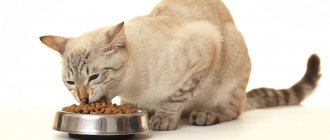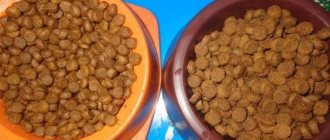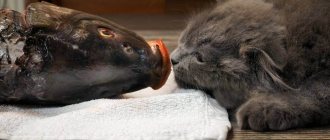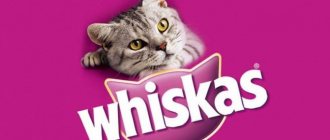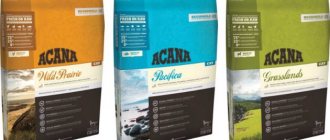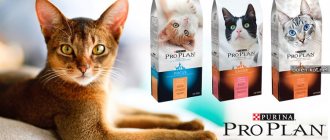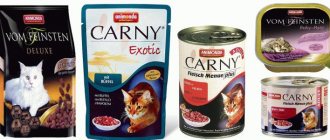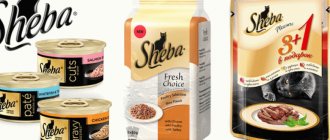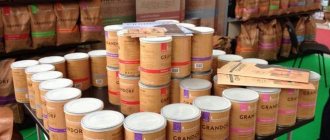Many owners of furry pets think that it would be a good idea to feed their cats natural food. But this is not as simple as it seems at first glance. It is difficult for an ordinary person to calculate the ratio of products in which the cat would receive all the nutrients, minerals and vitamins it needs. This is especially difficult for working people.
Therefore, in order to provide cats with a complete diet, conscientious manufacturers try to create food that would contain the most natural and healthy ingredients, as if the owner was feeding them natural products. One such cat food manufacturer is Champion PetFoods, based in Canada. She creates Acana products, a premium cat food.
Champion Pet Foods Factory
Acana cat food review
The Akan line only contains dry food. This company does not produce wet food. There is no separate Acana food for kittens. Little fluffies are fed the same as adult pets.
Akana stern
For your information! Acana for cats is a holistic food. The “holistic” label on the packaging means that it is made from natural ingredients, is completely balanced and complete, and does not require any additives.
There are only three types of food in the Akana line:
- Acana Grasslands;
- Acana Pacifica;
- Acana Wild Prairie.
Acana Grasslands
Calorie content
Domestic cats that lead a sedentary lifestyle are prone to obesity. Champion Pet Foods experts took this point into account when developing the composition of the finished food. Therefore, the bulk of calories come not from carbohydrates, but from proteins and fats. Accordingly, Akana provides the pet with energy, but not excess fat.
Acana Pacifica
Depending on the type of feed, the calorie content is as follows:
- Acana Grasslands. 4040 kilocalories per kilogram or 485 kilocalories per 120 g. Kilocalories are distributed as follows: 42% - fats, 37% - proteins, 21% - vegetables and fruits;
- Acana Pacifica. Slightly more nutritious, 4080 kilocalories per kilogram or 490 kilocalories per cup of food (120 g). The proportion of kilocalorie distribution is as follows: 22% - vegetables and fruits; 36% - protein; 42% - fat;
- Acana Wild Prairie. The most energy-intensive of all Akan, 4100 kilocalories per kilogram or 492 kcal per 120 g of feed. Contains 22% vegetables and fruits; 36% - protein; 42% fat.
Acana Wild Prairie
Manufacturer
Representatives of the Canadian company Champion PetFoods sought to create a product that would best satisfy the needs of animals. This principle is known as “biologically appropriate.” Its concept is simple: to make food that is as balanced as possible and only from natural ingredients, which any cat or dog can easily get used to.
There are several points that must be strictly observed:
- Since cats, as a predatory biological species, ate meat throughout their entire evolutionary development, industrially produced food should fully meet their needs. Those. contain at least 75% meat and 90% protein.
- After heat treatment, meat loses most of its nutrients, so it should always be produced raw or fresh.
- A diet containing only one or two types of prey can be called meager. At Champion PetFoods, they use at least 3 types of meat and add variety by adding fish or chicken eggs. There are exceptions, but they are few (for example, the Acana Singles line, designed specifically for animals with food allergies, intolerance to certain components, and with digestive problems).
- Hunting cats raised on the street, having caught their prey, eat it all: along with the skin, entrails and cartilage. A person, trying to make digestion easier for a pet, tries to remove all this, and thereby makes a big mistake: after all, these parts often contain especially valuable components. They are present in Acana food.
- The predator rarely comes across carbohydrates in natural conditions, which is why Acana food contains neither potatoes nor grains, but contains only those vegetables and fruits whose glycemic index is low (i.e. there is no threat of diabetes).
- Manufacturers prefer to buy feed products nearby: in the same regions where production is located, namely in the Canadian state of Alberta. This is not just a state - it is the agricultural center of the country, the main supplier of fresh fish and meat, vegetables, fruits and berries.
The entire production process of Acana feed (Akana) - from food processing to packaging - takes place in one place. Genetically modified raw materials are not used, nor are dyes!
Acana food was first sold in 1975. Its creator, an ordinary farmer Reinhard Mählenfeld, owned a pet store and loved animals very much. For a long time, only veterinary drugs were on sale, but then Reinhard decided to try selling his own food for dogs and cats. The local animals ate them with great appetite, grew quickly and looked great, the animal owners were delighted, and Mählenfeld’s business quickly took off. Attempts to sell recipes to giant companies that successfully traded in the market were unsuccessful: they saw no point in getting involved with a small farmer and did not consider it necessary to invest in what they thought was a “low-profit” business. Then Reinhard, with the support of his loved ones, through many obstacles, opened his own production.
Composition of Acana feed
Gemon (food for cats and kittens): description and composition
In each of the three products, 75% is meat or fish, as well as offal. There is no need to be afraid of the presence of a liver, heart and kidneys; they are very important for cats. After all, in nature, small predators eat their prey whole.
Note! A quarter of the composition is vegetables and fruits, as well as herbal supplements.
Akana does not use potatoes or grains as additives. The raw materials used in production are not genetically modified.
Acana for cats contains an appropriate balance of taurine, omega-3 unsaturated fatty acids, fiber, fat, protein, calcium, phosphorus, ash, omega 3/6 fatty acids, and magnesium that are beneficial for cats.
The following types of meat and offal are used for production:
- turkey;
- duck;
- lamb;
- lamb fat;
- raw lamb tripe;
- liver, heart and kidneys of duck;
- dried lamb cartilage;
- lamb liver;
- chicken meat;
- chicken offal;
- turkey and chicken giblets;
- chicken fat.
For your information! Beef is difficult for a cat's gastrointestinal tract to digest.
Herbal Ingredients
Herbal composition:
- whole legumes: beans, red and green lentils, yellow and green peas;
- alfalfa as a source of fiber, protein, iron, magnesium;
- pumpkin to improve digestion;
- brown algae - supplier of selenium, iodine, magnesium, zinc, manganese;
- cranberry as one of the means for the prevention of urolithiasis;
- turnip greens, containing a lot of fiber;
- blueberries to improve vision;
- lavender, the smell of which attracts cats;
- milk thistle to prevent liver disease;
- marshmallow root, which has an anti-inflammatory and enveloping effect;
- Turmeric improves the secretion of bile, which is necessary for quality digestion of food.
Alfalfa - a source of magnesium
Supplements
Acana Holistic for Cats contains the following beneficial supplements:
- dry fermentation product Enterococcus faecium - beneficial bacteria that help digestion, they are part of the natural microflora of the cat's intestines;
- choline chloride 1000 mg - a derivative of vitamin B4, which has certain benefits for the cat's liver;
- zinc improves the condition of the skin and coat, has an anti-inflammatory effect;
- Copper is important for the formation of bone tissue and cartilage.
Important! Each package contains the recommended daily intake of Akana food for kittens and adult cats. If the cat has to be sterilized or is already sterilized, then you should give preference to Acana Grasslands, where there is the least amount of fish that is harmful to such pets.
How much should you give your cat?
If the cat has previously eaten other food, then Acana should be introduced gradually, adding 10-20% to the pet’s standard menu. The full transition takes place in 7 days.
To avoid overeating, it is necessary to monitor the daily intake of the product, and the animal should always have access to water.
Manufacturers do not recommend combining several Acana varieties, as this is fraught with gastrointestinal disorders. You need to choose one flavor that your pet will like most. Three meals a day at equal intervals are shown. It is important to monitor portion sizes, as overeating is fraught with complications for the gastrointestinal tract. Serving size is calculated based on the weight of the animal. The standard volume varies from 20 to 100 g per day. There should be clean water next to the food bowl. If your pet has scabies, rashes, or the condition of the fur has worsened, then you need to switch to another product.
Comparison table: different types of Acana food
| Name of food | Main Ingredients | Calorie content | Purpose | Price |
| Acana Grasslands | Northern pike, turkey, lamb, duck, eggs | 4040 kcal/kg | For all ages and breeds (including Maine Coons). The dosage is indicated on the package | From 370 to 3710 rub. |
| Acana Pacifica | Flounder, Pacific sardine, silver hake, herring, perch | 4080 kcal/kg | For all ages and breeds (including Maine Coons). The dosage is indicated on the package | From 370 to 3710 rub. |
| Acana Wild Prairie | Turkey, chicken, rainbow trout, northern walleye, eggs, | 4100 kcal/kg | For all ages and breeds (including Maine Coons). The dosage is indicated on the package | From 370 to 3710 rub.* |
Monge: food for cats and kittens, composition Monge
Note! There is no official opinion from veterinarians regarding Akan cat food, as well as regarding other similar products. But many well-known nurseries give preference to this brand.
Official website of Acana and Orijen
The official website of the Acana and Orijen brands will help you choose the best cat food. Here you will find not only a complete catalog of food and their detailed descriptions, but also learn a lot of useful information about the principles of biological compliance, get acquainted with the concept of “Meat Mathematics”, and in the “Where to Buy” section you will find stores that sell Acana cat food and Orijen.
Advantages and disadvantages
Akana cat food, like any product, has its advantages and disadvantages.
Pros of food
Our brand: food for cats and kittens, composition
The undeniable advantages include:
- use of high-quality meat and fish ingredients;
- absence of genetically modified products;
- absence of cereals and potatoes;
- the presence of beneficial bacteria and a vitamin-mineral complex;
- the composition is described in detail;
- well-designed feed dosage;
- It is easy to order from an online pet store, since this food is one of the most common.
Cons of food
The disadvantages include the following:
- price;
- difficulties in purchasing, since it is not sold in ordinary pet stores;
- contains legumes. Some veterinarians believe that cats and dogs should not eat legumes of any kind. They are not absorbed by the cat's body, trigger fermentation processes in the intestines, and lead to flatulence. May cause intestinal colic;
- Another controversial ingredient is collard greens. White cabbage is not a clear choice for cats; there are different opinions about leafy cabbage (kale);
- apples and pears, like all fruits, can also cause increased gas formation;
- Alfalfa, which is so popular in feed, can disrupt hormonal levels due to the large amount of phytoestrogens;
- spinach increases the risk of urolithiasis;
- For light-colored cats participating in exhibitions, brown algae is not recommended, as it gives a yellowish color to the coat (most likely due to the large amount of iodine).
Note! It should be borne in mind that not very healthy ingredients are contained either in processed form or in small quantities.
What changes in a cat's body after sterilization?
The fact that the animal ceases to experience sexual heat (in the case of complete and proper sterilization) and loses the ability to reproduce is quite obvious; in fact, it is in most cases the purpose of the operation. However, less obvious changes also occur in the cat’s body and behavior, which cannot fail to attract the attention of loving owners.
Suppression of reproductive function leads to inevitable hormonal changes: in cats, the production of estrogen gradually stops, in cats - testosterone. Normally, sex hormones speed up metabolism, suppress appetite, and affect the aggression and activity of animals. Accordingly, their absence may lead to the fact that after surgery your pet will ask for food more often, spend more time in quiet contemplation instead of searching, and burn calories less quickly. As a result, the risk of overfeeding increases many times over, which, in turn, leads to such problems as obesity, diabetes, urolithiasis, heart failure and others.
Is it possible to avoid weight gain in spayed and neutered cats? Undoubtedly. And the first condition is not to follow the wishes of the pet, strictly observing the daily feeding norms. The second is to encourage him to play, move, and provide an additional source of interest other than food. Finally, the third thing, but not least, is to choose the optimal diet for a sterilized cat. Let's look at this in more detail.
How much does it cost and where to buy Akana food?
This brand is a premium one, so the food cannot be cheap. Its price starts from 370 rubles. per 340 gram pack. The most expensive package is 5.4 kg - from 3,710 rubles.
This brand of food is available in the following retail pet store chains:
- Beethoven;
- Four paws;
- CATFISH;
- Vetlek;
- Doberman;
- Markvet;
- ZooGallery;
- ZooLakki;
- Zoo booth;
- Grasshopper;
- Dinosaur;
- Pet;
- Feed rate;
- Old Farm;
- Pet market.
From online stores it is offered:
- Old Farm;
- Petshop.ru
Alternative
The best replacement would be food from the same manufacturer - Orijen. This line is represented by the following products:
Orijen Tundra, which includes:
- meat of wild boar, duck, deer, goat and their offal;
- mutton and lamb;
- fish: arctic char, rainbow trout, mackerel, sardine, blue whiting, cod;
- legumes: green and red lentils, chickpeas, yellow and green peas, beans;
- fruits and berries: apples, pears, blueberries, cranberries, rose hips, juniper;
- turmeric;
- vegetables: zucchini, pumpkin, kale (leaf), parsnips, carrots, spinach, beet and turnip tops;
- brown algae;
- roots: marshmallow, sarsaparilla, chicory.
Note! This food is for all breeds and ages.
Orijen Fit & Trim is available for overweight cats. Its composition:
- chick;
- eggs;
- mackerel;
- turkey and its offal;
- Pacific hake;
- flounder;
- pollock;
- sardine;
- herring;
- lavender flowers;
- peas, chickpeas, lentils, beans, navy beans;
- berries of serviceberry.
Orijen food is a good alternative to Akana food
Thus, Akana food, although not without certain drawbacks, is much better suited for feeding domestic cats than the cheap options sold in every store. It is available for purchase in many stores, but is quite expensive.
*Prices are as of October 2022.
